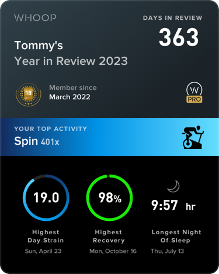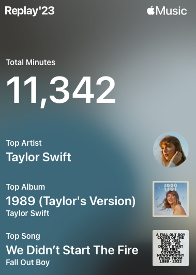Examining End-of-Year Statistics for Personal Growth
- Tommy Sangchompuphen

- Jan 5, 2024
- 3 min read
Seeing all my friends sharing their “My Year in Books” on various social media platforms was making me jealous. “My Year in Books” is a feature offered by Goodreads, a popular book recommendation and cataloging website.
I imagine “My Year in Books,” which includes various statistics and insights such as total books and total pages read, is popular among Goodreads users as it offers insights, in my opinion, into intellectual pursuits by revealing reading habits, literary preferences, and engagement with various genres and themes.
To me, “My Year in Books” reflects intellectual curiosity, areas of knowledge interest, and the desire for cognitive stimulation. That might not be how Goodreads users view it, but that's my perception.
I don’t have a similar year-end summary like “My Year in Books” that I can share. Not. Even. Close.
Instead, my year-end recaps are from McDonalds (I’m an “MVP Redeemer” who frequently gets the Filet-O-Fish®); Dunkin’ (my favorite order includes a strawberry-frosted sprinkled donut and a chocolate frosted donut); Calendly (my most popular day to meet is Friday); Chess.com (I lose more than half the games I played); WHOOP (my longest night of sleep was 9 hours 57 minutes); Peloton (I burned 170,431 calories); Panera Bread (I ordered 237 beverages as a member of its Sip Club); and Apple Music (I’m a confirmed Swiftie), to name just a few. It’s a good thing that Taco Bell and White Castle don’t have year-end recaps (yet)—those could prove quite embarrassing for me.
At first, I felt a bit of FOMO not having a similar “My Year in Books” recap.
But then I realized that examining my own end-of-year statistics, even from non-intellectual pursuits, can be equally informative and instrumental in guiding personal growth.
On a broad level, I can assess the balance in my life by examining my own year-end statistics collectively. For example, how does my physical activity (tracked by Peloton and WHOOP) correlate with my eating habits (McDonald's and Dunkin')? Are my meetings (Calendly) affecting my sleep patterns (WHOOP)? This holistic view allows me to identify areas where changes could bring more harmony into my life.
While examining my year-end statistics on a broad level offers a valuable overview of my lifestyle balance, diving into a more detailed analysis can provide specific insights into my daily routines and choices. This closer examination helps in pinpointing exact habits or moments where small, targeted changes could make a significant difference.
🔬👟 Statistics from fitness companies like Peloton or health trackers like WHOOP provide concrete data on physical activity, sleep patterns, and overall wellness. This information is crucial for assessing physical health, setting fitness goals, and understanding the impact of lifestyle choices on bodily well-being.
🍔 🍩 Data from frequent visits to places like McDonald's or Dunkin' can highlight dietary patterns. Such insights are valuable for nutritional planning, understanding eating habits, and making informed decisions about food choices, which are integral to maintaining good health.
📅 ⏰ Statistics from apps like Calendly, which track meetings and appointments, reveal how time is allocated between work, personal pursuits, and rest. This data can be used to balance various aspects of life more effectively, enhancing productivity and ensuring sufficient time for relaxation and hobbies.
☕️ 🏪 Analyzing spending patterns at coffee shops and restaurants or on subscriptions (like Panera Bread’s Sip Club) offers a window into financial habits. This information is essential for budgeting, understanding spending priorities, and adjusting to ensure financial health and goals are aligned.
🎶🍴 Preferences in music (from Apple Music) or dining out habits can also provide insights into social tendencies and emotional states. Music preferences might reflect mood patterns or cultural interests, while dining choices could indicate socializing habits or comfort-seeking behaviors.
So, while Goodreads statistics may provide insights into intellectual pursuits and cognitive interests, statistics from non-intellectual activities can also provide a comprehensive overview of different aspects of life to guide personal growth.


























